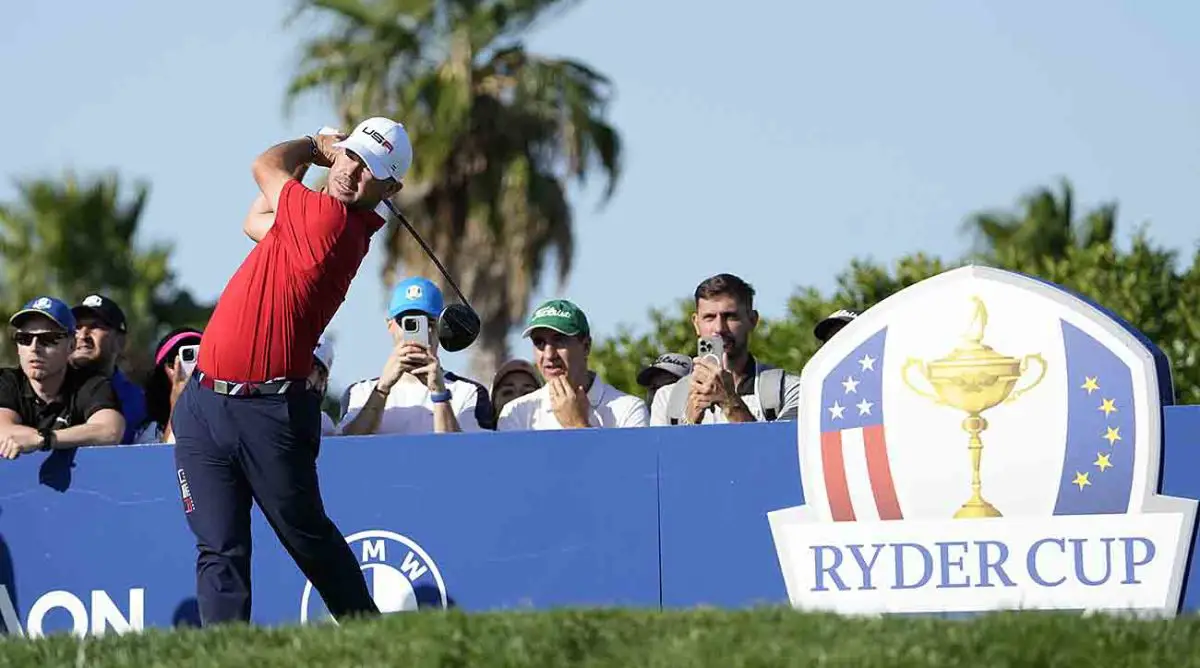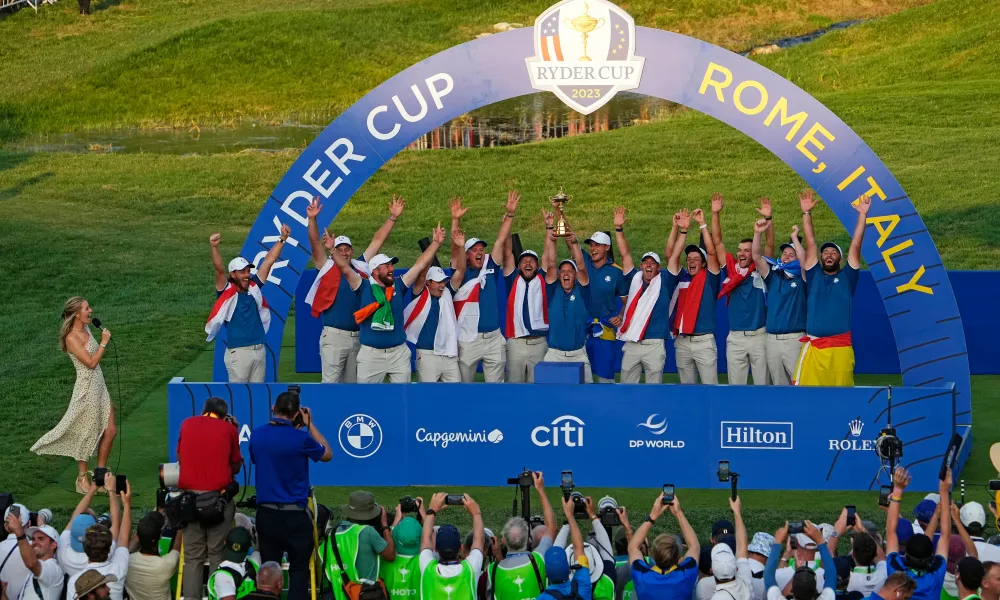
The Ryder Cup is a golf tournament that takes place every other year and is known for its rowdy crowds and World Cup-style spectacle. The biannual exhibition between the greatest professional players from the United States and those from Europe is appointment viewing for ardent golfers and casual fans alike.
History of the Ryder Cup
The United States and Europe compete in the Ryder Cup every other year in a match-play tournament. Samuel Ryder, a successful businessman and avid golfer endowed the competition with a solid gold trophy. In 1927, the Ryder Cup was played for the first time at Worcester Country Club in Worcester, Massachusetts.
Before a rule change in 1979, only professionals from the United States and Great Britain could compete in the Ryder Cup.
With 24 victories, the United States leads Great Britain/Europe by a wide margin (10 wins), but there have also been two ties in the Ryder Cup’s history. Due to World War II and the September 11th events in 2001, the event was postponed during those years.
Rules of the Ryder Cup
There has been a battle between the United States and Europe for the Ryder Cup every two years since 1927. (though some years have been skipped). There are a total of 28 games, with one point at stake per contest, spread over fourball, foursome, and singles play.
How to Play the Ryder Cup?
Players chosen to represent each of two teams of twelve competes in a series of match-play events known as the Ryder Cup. Over the tournament’s three days, from Friday to Sunday, there are a total of 28 matches, and each one lasts for 18 holes. On Friday and Saturday, eight matches will be played, with four fourball matches and four foursomes spread between the morning and afternoon sessions, respectively. On Sunday, all team members will compete in 12 individual matches. On Friday and Saturday, the captain can sit out some or all of the games by choosing a different group of eight players to play in each session.
Scoring System
The victorious team receives one point, the tying team receives half a point, and the losing team receives no points for the match. The Ryder Cup is awarded to the team with the highest number of points without a tie.
Each hole won is worth one point, while a tie on a hole is worth half a point, much like in the overall Ryder Cup scoring system. After each match in the Ryder Cup, the team with the higher point total earns a point for their team.
If, after 28 games, the score is 14 games apiece, the team currently in possession of the Ryder Cup will keep it. Consequently, if the 2021 Ryder Cup also ends in a tie, the 2018 champion, Team Europe, would retain their title.
Fourball
For the Ryder Cup, the United States and Europe field two-golfer teams that compete for over 18 holes in a format known as fourball. There will always be four balls in play on any given hole because each golfer uses their ball (hence the name).
After completing the hole, each team will add up the scores of its two players, and the team with the lowest total score will earn a point for that hole. Teams split the point for the hole if the lowest individual score is a tie between two teams.
Using the previous scenario, if two members of Team A shot two over and one shot three under on the same hole, only the latter score would be recorded. In the event where both players on Team B shot two under par, just that score would be recorded for that hole. If both teams’ lowest scores were three under, Team A would win.
Foursome
In golf, a quartet is a group of four people. Although it is played by two teams of four, foursomes is a little more sophisticated than fourball. Instead of each player using their ball on a particular hole, team members take turns using the same ball. They take turns hitting the tee.
On Hole 1, for instance, Team Member A would drive, followed by Team Member B playing the ball; if the two of them could make par on a par-3 hole, then Team Member A would sink the ball on the third total stroke. Team B would take the wheel on Hole 2, and then Team A would drive on Hole 3, and so on.
Each hole’s point goes to the group that finished with the lowest score. In the event of a tie, each team receives 0.5 points for that hole.
How Are Singles Scored?
Fans of stroke play are most likely familiar with the singles scoring format. Unlike in fourball and foursomes, where each golfer must keep track of three other people, in singles play, each match contains one player from each team and lasts for 18 holes.
Players get points for better scores on individual holes and half points for ties as they play. At the end of each match in the Ryder Cup, the player whose team has won the most holes contributes to their team’s score. A tie (nine holes apiece) is worth half a point in the Ryder Cup.
What Does “Concessions” Mean in the Ryder Cup?
In match play, players are not required to finish each hole they begin, unlike in stroke play. So, if a player gives away a stroke (often a putt) to their opponent, their opponent picks up their ball, makes whatever score they would have made on their next stroke, and continues on to the next hole.
Even in match play, it is possible to build an insurmountable lead. Any golfer or golf team can concede a match when they see they can’t catch up to their opponent in the remaining holes.
In golf, a score of “3 and 2” indicates that the winning team or player had a three-hole lead with two holes to play; even if the opponent won the final two holes, they would still be behind by one hole. Similarly, a “2 and 1” score indicates a two-stroke advantage with one hole remaining. The “6 and 4” victory by Tony Finau over Europe’s Tommy Fleetwood in singles match play at the 2018 Ryder Cup was the highest unsurmountable deficit of any kind.
Some Important Terms
A golfer or partnership can “go one up” if they win the 18th hole and are still tied after 17 holes.
Going “2 up” in golf means one player or team holds a two-hole lead over another after the 18th hole. Whenever a golfer is trailing by one or more strokes going into the final hole, play must continue if the losing golfer(s) can win that hole and bring about a tie.
If no player or pairing on either team wins a hole, the score is termed a halve, and each team receives a half point.
All square (AS) is the term used to describe a tied match in progress.
When a team or golfer has a lead of exactly two strokes with two holes remaining in a match, they are said to be “dormie,” whereas when they have a lead of three strokes with three holes remaining, they are said to be “dormie” and so on. Having “dormie” status indicates that you cannot lose and only need another half point to win.
Selection of Players
The captain of each team selects the pairings for fourball and foursomes games and the order of players to play in singles competitions.
Players for the Ryder Cup are chosen after a long qualifying process that takes several years and is based on a point system that rewards recent success and major winners with money from major championships, World Golf Championships, and regular PGA Tour tournaments.
The United States usually has eight players who qualify based on points, and the captain chooses the other four players. Nevertheless, the United States declared that only six players would qualify through points. Captain Steve Stricker would make six captain choices instead of four when the 2020 Ryder Cup was postponed to 2021 because of the coronavirus outbreak.
The top four players who are on the European Points List and the top five on the World Points List automatically qualify for the European squad, leaving three captain’s picks.
Time of the Play
On the first two days, play will begin at 1.05 pm BST, with the foursomes matches beginning at 1.21 pm, 1.37 pm, and 1.53 pm.
On Friday and Saturday, the fourball matches in the afternoon will start at 6:10 pm, the other three matches will begin at 6:26 pm, 6.42 pm, and 6.58 pm, and the tournament is slated to wrap up around 12:30 am.
The singles match on Sunday begins at 5.05 pm BST, with games starting at 11-minute intervals and the last match scheduled to begin at 7.05 pm. The last game is scheduled to end at 11 pm, followed by the awards presentation.
Changes in Rules Over the Years
The Ryder Cup has gone through several different formats over the years. From its start in 1927 until 1959, each Ryder Cup was played over two days and 36 holes. After doubling the number of matches and increasing the length of each match to 18 holes in 1961, the game quickly became a fan favorite. The tournament lasted three days and was expanded to include a fourball competition in 1963.
The number of matches was reduced from 32 to 20 in 1977, but in 1979, the first year players from continental Europe took part, the tournament was expanded to its current length of 28 matches, with 8 foursomes/fourball matches played over the first two days and 12 singles matches played over the final day. The 2010 competition was amended and held on a fourth day due to weather-related delays.
In 1969, the squad size was bumped up from 10 to 12.
In 1979, there were two singles sessions (one in the morning, one in the afternoon), although no player participated in both.
Every year since 1979, the first two days of the tournament have featured eight groups of four players, with four foursomes and four fourballs. At the moment, the home captain decides before the tournament starts whether the morning games will be fourball or foursomes. If he wants, he can switch the two days around.
From 1963–1975, players were permitted to play six matches per year, consisting of 2 foursomes, 2 fourballs, and 1 singles match (2 foursomes, 2 fourballs, and 2 singles matches).
Champions of Ryder Cup
The Ryder Cup is a biennial golf match between teams from Europe and the USA. It has been held since 1927. In both 1969 and 1989, contests ended in draws. In the years between 1935 and 1985, Europe was victorious exactly once.
Table 1: Champions of the Last five years
| Edition | Year | Country |
| 43rd | 2021 | United States |
| 42nd | 2018 | Europe |
| 41st | 2016 | United States |
| 40th | 2014 | Europe |
| 39th | 2012 | United States |
The Highest Scorers Throughout the Past Five Years
39th (2012)
United States of America’s leading scorer is Dustin Hunter Johnson (3 for 3).
Poulter is the British leader in scoring.
40th (2014)
USA’s top scorer is Patrick Nathaniel Reed (3.5/4).
Rose, Justin Peter, is Britain’s top scorer (4/5).
41st (2016)
Patrick Nathaniel Reed got the highest rating in the United States (3.5/5).
Britain’s top scorer, Thomas Pieters (4/5).
42nd (2018)
U.S.A.’s Leading Scorer (Justin Louis Thomas, 4/5).
British No. 1: Francesco Molinari (5/5).
43rd (2021)
United States of America’s top scorer is Dustin Hunter Johnson (5/5).
For the British team, Jon Rahm Rodriguez scored the highest (3.5/5).
Conclusion
So, here is all about the rules of the Ryder Cup. We hope you’ve found this article useful to learn something new about your favorite sport, the Ryder Cup.
- Related: Ryder Cup 2023 Ticket Prices













